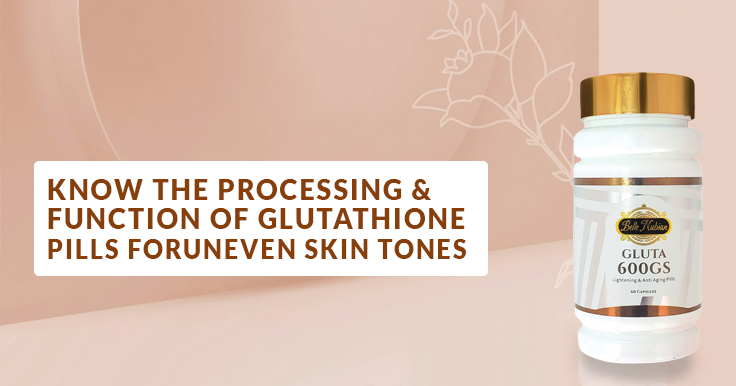- No products in the cart.
Know The Processing and Function Of Glutathione Pills for Uneven Skin Tones
15
Nov
Fixing skin that has been sun damaged, has hyperpigmentation or even an uneven skin tone is the process of employing chemical compounds to level out the skin's colour by lowering the skin's melanin content to that of your body’s overall natural skin tone. Several compounds have been demonstrated to be helpful in aiding an uneven skin tone, whereas others have been shown to be damaging or have safety concerns on the skin. Mercury compounds, for example, have been linked to neurological and renal disorders. Plants, mammals, fungi, and certain bacteria and archaea produce Glutathione, an antioxidant that is the best natural skin remedy for hyperpigmentation. Reactive oxygen species such as free radicals, peroxides, lipid peroxides, and heavy metals can harm essential cellular components, but glutathione can protect them.
Occurrence And Biosynthesis
Two adenosine triphosphate-dependent stages are involved in glutathione biosynthesis:
- L-glutamate and cysteine are used to make gamma-glutamylcysteine. The enzyme glutamate–cysteine ligase is required for this reaction (GCL, glutamate cysteine synthase). The rate-limiting step in glutathione production is this reaction.
- Glycine is added to the gamma-glutamylcysteine C-terminus. Glutathione synthetase catalyses this condensation.
While glutathione can be synthesised by all animal cells, glutathione production in the liver has been proven to be important. The lack of hepatic GSH production causes GCLC knockout mice to die within a month of birth. The gamma amide bond in glutathione protects it against peptidase hydrolysis.
Occurrence
While glutathione can be synthesised by all animal cells, glutathione production in the liver has been proven to be important. The lack of hepatic GSH production causes GCLC knockout mice to die within a month of birth. The gamma amide bond in glutathione protects it against peptidase hydrolysis. It is the best evening tone solution for all skin types.
Function Of Biochemistry
Glutathione comes in two forms: reduced (GSH) and oxidised (GSSG). The ratio of reduced glutathione to oxidised glutathione inside cells is a measure of cellular oxidative stress where higher GSSG-to-GSH ratio is suggestive of greater oxidative stress. More than 90% of the total glutathione pool in healthy cells and tissue is in the reduced form (GSH), with the rest in the disulfide form (GSSG). The thiol group of the cysteinyl residue provides a source of one reducing equivalent in the reduced state. Glutathione disulfide (GSSG) is produced as a result. NADPH converts the oxidised state to the reduced state. Glutathione reductase catalyses this conversion:
NADPH + GSSG + H2O → 2 GSH + NADP+ + OH−
Roles
Antioxidant
By neutralising (i.e. decreasing) reactive oxygen species, GSH protects cells. The decrease of peroxides exemplifies this transformation:
2 GSH + R2O2 → GSSG + 2 ROH (R = H, alkyl)
in addition to free radicals:
GSH + R. → 0.5 GSSG + RH
Regulation
Protein S-glutathionylation, a redox-regulated post-translational thiol modification, participates in thiol protection and redox control of cellular thiol proteins under oxidative stress, in addition to deactivation radicals and reactive oxidants. The protectable protein (RSH) and GSH combine to produce an unsymmetrical disulfide in the general reaction:
RSH + GSH + [O] → GSSR + H2O
Glutathione is also used to detoxify hazardous compounds such as methylglyoxal and formaldehyde, which are generated during oxidative stress. The glyoxalase system is in charge of this detoxifying process.






